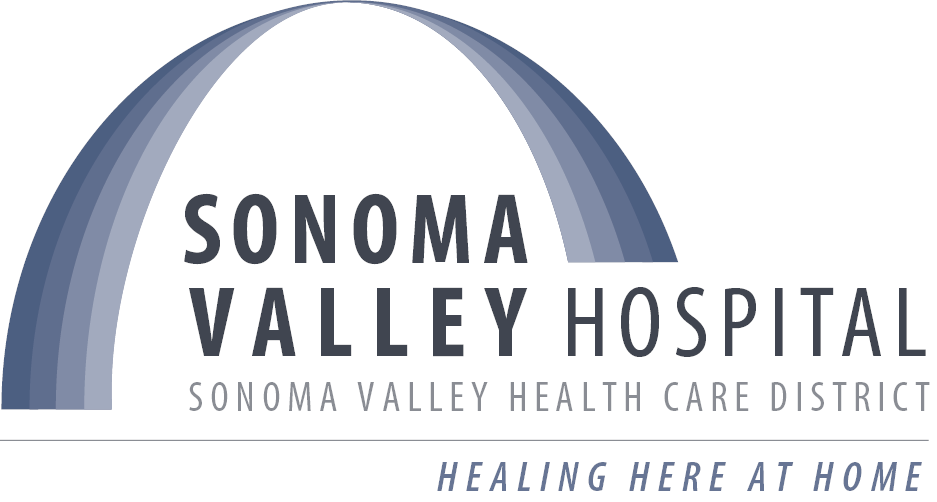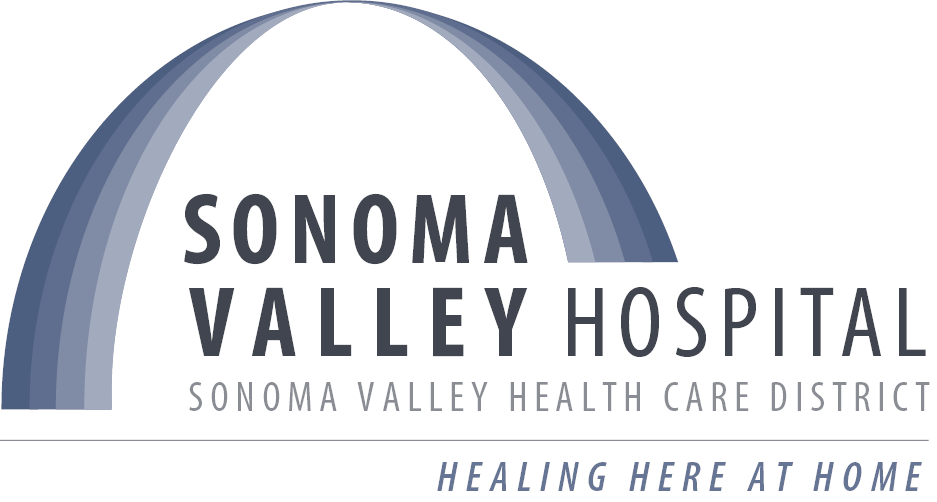Navigating the Holidays During COVID and Flu Season
All of us at Sonoma Valley Hospital wish everyone a safe and joyful holiday season. It will be challenging to remain safe given that the pandemic continues to rage, and now we are in flu season. To stay healthy, we encourage everyone to be flexible with their plans and traditions. We have gathered some recommendations from several expert sources that will help all of us to safely navigate the holiday season.
The Five Essentials
Everyone is encouraged to practice the five essentials:
Get Vaccinated + Booster Covid-19 Vaccines are available to everyone 5 years and older, Boosters are available to everyone 12 years and older.
Wear Your Mask Properly Indoors (and outdoors as needed) Be certain to cover your nose, mouth, and chin.
Safe Distancing Stay at least 6 feet apart, especially when around more than one person.
Wash Your Hands Do this with soap and water as often as possible.
Get Tested If you have symptoms of COVID-19, especially if you’ve been exposed to someone with the virus, you should get tested.
About Travel
“The way to show family member we love them this holiday season is by keeping them safe. The best way to keep them safe is to not travel to see them due to the increased likelihood of contracting COVID while traveling. If you are with family that you don’t normally live with this season remember: masking, handwashing and physical distancing.” – Stephanie Montecino, Infection Preventionist, Sonoma Valley Hospital
Sonoma Valley Hospital, along with several other national health agencies and institutions, recommends not to travel this holiday season.
Know the risks
Health experts across the country are asking everyone to take measures to reduce the spread of COVID-19. Virtual celebrations pose the lowest risk of spreading COVID-19. Promoting healthy behaviors will reduce the spread. The risk of COVID-19 spreading at events and gatherings increases as follows (SOURCE: CDC):
Lowest risk: Virtual-only activities, events, and gatherings
More risk: Smaller outdoor and in-person gatherings in which individuals from different households remain spaced at least 6 feet apart, wear masks, do not share objects, and come from the same local area (e.g., community, town, city or county)
Higher risk: Medium-sized in-person gatherings that are adapted to allow individual to remain spaced at least 6 feet apart and with attendees coming from outside the local area.
Highest risk: Large in-person gatherings where it is difficult for individual to remain spaced at least 6 feet apart and attendees travel from outside the local area.
If you do travel
According to health experts at the CDC, travel increases the chance of getting and spreading the virus that causes COVID-19. If you must travel, be informed of the risks involved and how to best prepare. Here are some basic guidelines: (Learn more HERE.)
- Check travel restrictions before you go.
- Get your flu shot before you travel
- Always wear a mask in public settings, when using public transportation, and when around people you don’t live with.
- Stay at least 6 feet apart from anyone who does not live with you.
- Wash your hands often or use hand sanitizer.
- Avoid touching your mask, eyes, nose, and mouth.
- Bring extra supplies, such as masks and hand sanitizer.
Consideration for Gatherings
The Centers for Disease Control and Prevention (CDC) offers the following considerations to slow the spread of COVID-19 during small gatherings. These considerations are meant to supplement – not replace – any state, local, territorial, or tribal health and safety laws, rules, and regulations with which all gathering must comply.
Considerations for Small Gatherings of Family and Friends
More information HERE
Several factors can contribute to the risk of getting and spreading COVID-19 at small in-person gatherings. In combination, these factors will create various amounts of risk:
- Community levels of COVID-19 – High or increasing levels of COVID-19 cases in the gathering location, as well as in the areas where attendees are coming from, increase the risk of infection and spread among attendees. Family and friends should consider the number of COVID-19 cases in their community and in the community where they plan to celebrate when deciding whether to host or attend a gathering. Information on the number of cases in an area can often be found on the local health department website.
- Exposure during travel – Airports, bus stations, train stations, public transport, gas stations, and rest stops are all places travelers can be exposed to the virus in the air and on surfaces.
- Location of the gathering – Indoor gatherings, especially those with poor ventilation (for example, small enclosed spaces with no outside air), pose more risk than outdoor gatherings.
- Duration of the gathering – Gatherings that last longer pose more risk than shorter gatherings. Being within 6 feet of someone who has COVID-19 for a cumulative total of 15 minutes or more greatly increases the risk of becoming sick and requires a 14-day quarantine.
- Number and crowding of people at the gathering – Gatherings with more people pose more risk than gatherings with fewer people. CDC does not have a limit or recommend a specific number of attendees for gatherings. The size of a holiday gathering should be determined based on the ability of attendees from different households to stay 6 feet (2 arm lengths) apart, wear masks, wash hands, and follow state, local, territorial, or tribal health and safety laws, rules, and regulations.
- Behaviors of attendees prior to the gathering – Individuals who did not consistently adhere to social distancing (staying at least 6 feet apart), mask wearing, handwashing, and other prevention behaviors pose more risk than those who consistently practiced these safety measures.
- Behaviors of attendees during the gathering – Gatherings with more safety measures in place, such as mask wearing, social distancing, and handwashing, pose less risk than gatherings where fewer or no preventive measures are being implemented. Use of alcohol or drugs may alter judgment and make it more difficult to practice COVID-19 safety measures.
The following people should NOT attend in-person holiday gatherings
People with or exposed to COVID-19
People at increased risk for severe illness
Considerations for Events and Gatherings – Guiding Principles
More information HERE
- A gathering refers to a planned or spontaneous event, indoors or outdoors, with a small number of people participating or a large number of people in attendance such as a community event or gathering, concert, festival, conference, parade, wedding, or sporting event.
- The more people an individual interacts with at a gathering and the longer that interaction lasts, the higher the potential risk of becoming infected with COVID-19 and COVID-19 spreading.
- The higher the level of community transmission in the area that the gathering is being held, the higher the risk of COVID-19 spreading during a gathering.
- The size of an event or gathering should be determined based on state, local, territorial or tribal safety laws and regulations.
Connecting with Others
Even though we are being encouraged to limit travel and interactions there are many things we can still do that will keep us connected and in the holiday spirit. Emerson Hospital (Concord, MA) provides some creative ideas to celebrate the holidays in joyful, safe, and meaningful ways. (Learn more HERE):
Check in on loved ones
Everyone, no matter what they might reveal on their social media posts, is going to have some challenging times ahead. It is not easy to get through a holiday season during a global pandemic. Call your family, friends, neighbors, long-ago acquaintances. If you make one call each week, you will impact many lives this winter season.
Get outside and exercise!
Take your immediate family out for a long walk or run on a holiday morning. Throw a football around, discover a new nature trail, hit the beach, ride the bike, roller skate or skate board. Don’t forget a camera. Enjoying nature is one of the best ways to soothe your soul this holiday season. (Sonoma Valley Regional Parks)
Host a neighborhood drive to collect items for a local food bank
Circulate a flyer or an email to neighbors, put a collection bin on your front stoop and drop off the donations at one of our local food banks in Sonoma Valley. It is best to contact the organization before starting the drive to find out what the logistics are to donate and if they need anything specific in the way of food, toiletries, baking items, etc. (See list below)
Share traditional recipes
Share traditional recipes with family members. While you all won’t be physically in the same place this holiday season, you can still enjoy grandma’s apple pie and your great uncle’s gravy. Have a virtual family meeting to plan your festive meals and swap recipes.
Think out-of-the-box for holiday gift giving
Health experts recommend avoiding crowded stores whenever possible. If you must go to a store, go during off-peak times to avoid crowds, and shop local. Consider gift shopping online or call local shops that you want to support and ask if they can mail gifts or gift cards to recipients. This is the season to think creatively — often the most meaningful gifts are the most creative ones. (Links to Go Local Sonoma County and Sonoma Valley Chamber of Commerce)
“Zoomolidays.”
It can be meaningful to see loved ones gather around their respective tables for the holidays, and Zoom can help. You can spice up Zoom with fun contests, like “most creative table setting,” “best decorations for the holidays,” or “most delicious looking desserts.” (Zoom.US)
Identify new hobbies
For many people, the holidays signify the start of the winter season. Everyone’s patience will be tested this winter as we aim to control the spread of COVID-19 with necessary safety precautions. This is a great time to find some new hobbies. Follow your passions. How about trying a new craft or starting a podcast? Consider volunteering remotely for a non-profit you care about. Try a winter sport, discover a new or old book, host a virtual game night with your family or friends, learn a new language….the possibilities are endless.
COVID-19 and the Flu: Similarities and Differences
The CDC reports that there are key differences between flu and COVID-19. COVID-19 seems to spread more easily than flu and causes more serious illness in some people. To learn more about the similarities and differences, please visit the CDC’s website on the “signs and symptoms” for COVID-19 and flu here – ENG SPN
Sources
Sonoma County Department of Public Health “Recommendations for Staying Safe From COVID-10 During the Holidays” ENG SPN
UCSF School of Medicine “Holiday Gatherings During COVID-19: What Doctors Say About Traveling and Family Events” LINK
Emerson Hospital (Concord, MA) “A Season of Good Health – Tips for the Holidays in the Pandemic” LINK
Cleveland Clinic #MaskUp LINK
Centers For Disease Control and Prevention:


